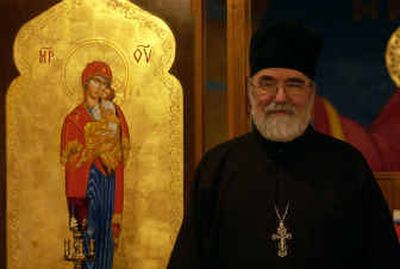Priest followed a different way and found his place

The Rev. William O’Brien grew up Roman Catholic. His uncle was a priest and beginning at the age of 5 O’Brien thought he might like to become a priest. But when he did finally get ordained, it was in the Ruthenian Catholic Church, also known as Byzantine Catholic.
The Ruthenian Catholic Church has its roots in Slovakia and Ukraine and was one of several Eastern rite churches that split from Rome and the Pope in 1054, including the Antiochian Orthodox Church. The Ruthenian Church rejoined with Rome in 1646 and is now one of 22 different branches of the Catholic faith headed by the pope, O’Brien said.
O’Brien said he was heavily influenced by his uncle. “He’d come down and visit us every Saturday. He was a priest for 52 years.” But after his initial youthful thoughts of becoming a priest, O’Brien set it aside. He went to college and began working in California as a computer programmer. “I had a great life in California. I knew there was something missing.”
Then on Holy Thursday in 1982 he stumbled into a Byzantine Catholic Church. “I’d never been in an Eastern (rite) church before,” he said. “I just had this feeling, ‘I’m home.’ I can’t explain it. I found something that was beautiful, and I stayed.”
Soon he received the extra push he needed toward ordination. “Sometimes the Lord gives you a good swift kick in the butt when you need it. I was fired from my job.”
O’Brien quickly found another job, but the experience made him revaluate his life and really think about where he was and what he wanted to be doing with his life.
There is a procedure in the Catholic Church that allows a member to apply for a transfer of rite. It can only be done once in a lifetime and transfers a person’s membership from one Catholic rite to another. O’Brien applied for the transfer to the Byzantine church and then petitioned to attend the seminary.
Still, he experienced the normal uncertainty when he quit his job, cleaned out his apartment and prepared to move across the county to attend seminary. Then he arrived on campus. “I took one look, and all the fear was gone,” he said. “It was a wonderful experience. I had a ball.”
O’Brien’s first job as a priest was at Saints Cyril and Methodius Byzantine Catholic Church in Spokane Valley in 1988. He stayed for five years, then left for other parishes in the Van Nuys (Calif.) Eparchy, or diocese. He came back to Spokane Valley two years ago. “I love it here,” he said.
The only downside is his isolation from other Eastern rite priests. The nearest Byzantine churches are in Seattle and Olympia. But he does keep connected to the Catholic Diocese of Spokane. “I have a lot of good friends among the Roman priests.”
The basic beliefs in the Byzantine Catholic and Roman Catholic churches are the same. But in Byzantine churches the priest says Mass while facing away from the congregation and in Europe some Byzantine priests are allowed to marry. The churches simply express their Catholicism differently, O’Brien said.
The structure of the weekly Divine Liturgy worship is similar to Eastern Orthodox churches, but has been said in English since the 1950s. “We like to think we’re a bridge between the two,” O’Brien said of Roman Catholic and Eastern Orthodox worship styles. “We didn’t change anything, we just translated it.”
O’Brien is happy with his decision to become a part of the Byzantine Catholic Church. “The Lord led me a different way. I know where I’m supposed to be.”